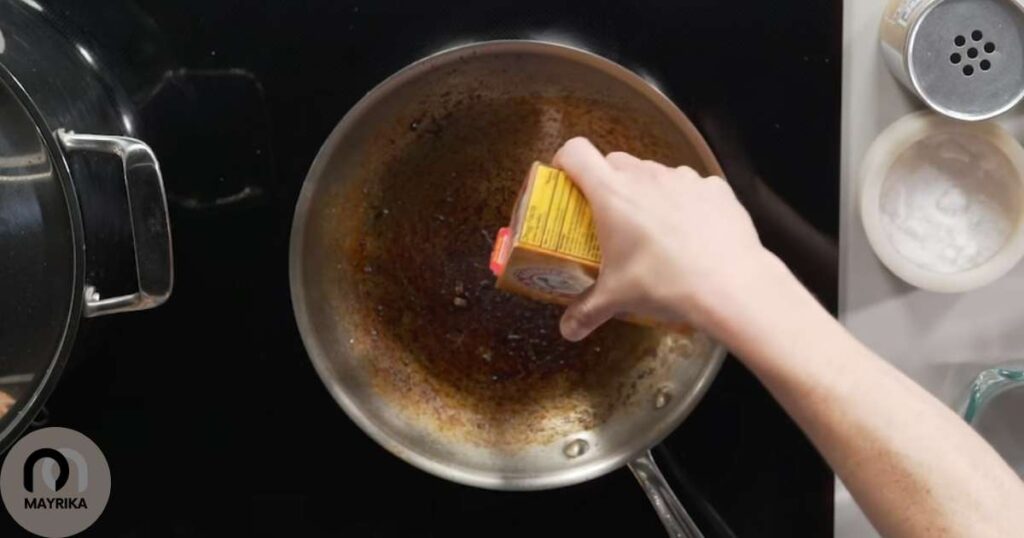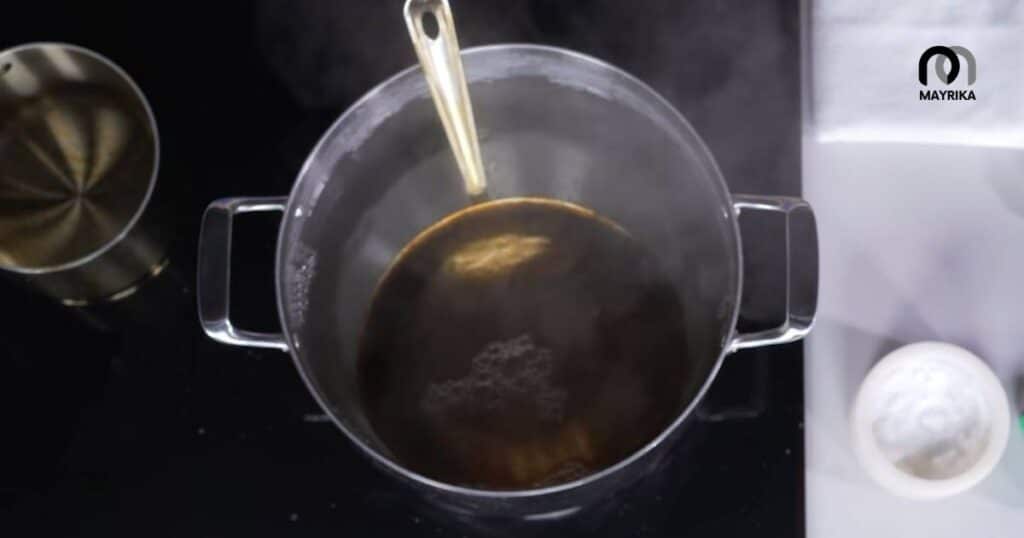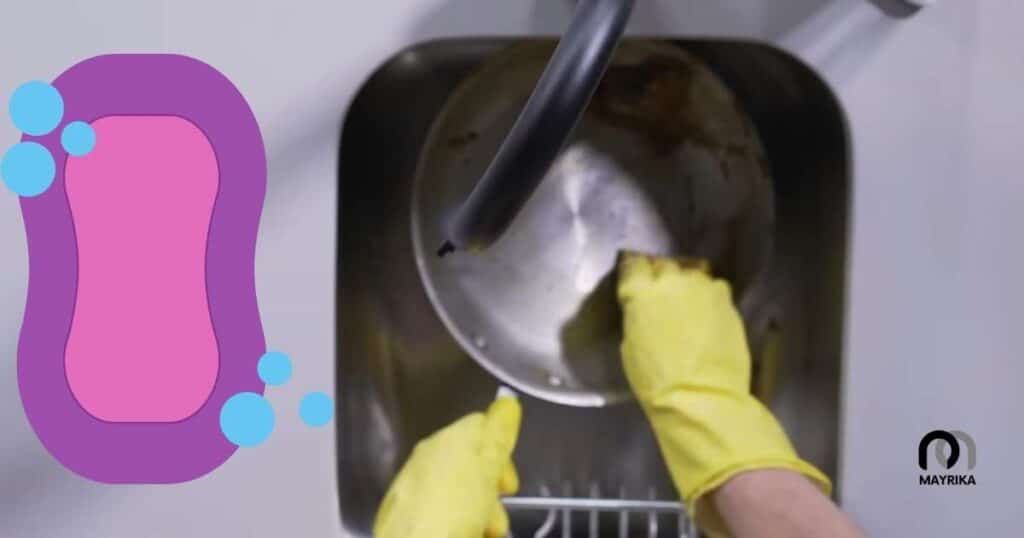Cleaning stainless steel cookware can be a tedious task, but it is not impossible. The first thing you need to do is gather your supplies.
This includes an old dish towel or paper towel, baking soda, and water. Make sure that the sink has been prepped with hot water so that you can rinse everything down after cleaning.
Once these items have been gathered, start by wiping down the pot’s surface with a damp cloth to remove any debris or food particles from its surface.
Next, mix 1 tablespoon of baking soda and 3 tablespoons of warm water into one bowl while also filling another bowl with equal parts white vinegar and warm water for rinsing purposes later on in this process.
How to clean stainless steel cookware?
Stainless steel pots and pans can make your life easy if you know how to keep them clean. This kind of cookware is easy to clean, and it maintains its shine for a long time.
However, like all other things, it has to be cleaned regularly, or else the stains will stick on the pan’s surface and make it.
There are many ways to clean stainless steel cookware. Here are several methods.
Related: The Best Stainless Steel Nonstick Cookware Set: 7 Sets To Choose From

Basic cleaning for average messes
First, let’s keep in mind that water is the ideal cleanser for most stainless-steel cookware. So, bring some water to a quick rolling boil and scrub off dirt with a sponge or cloth.
But if there’s even just one little spot you have been unable to remove, it may be time for those store-bought miracle cleaners designed specifically for keeping your stainless-steel cookware immaculate.
These often come with built-in abrasives too (whether powered or not), which are perfect for scouring out stuck-on gunk.
A word of caution when it comes to cleaning any coating, including stainless steel be sure you’re using something other than ammonia-based products.
Baking soda and elbow grease
Your best bet is to find cookware with an easy-to-clean surface. Stainless steel cookware often comes pre-seasoned, so it’s not as necessary to add fat before cooking.
In food processors heavy on fats and oils, stainless steel can become a prime refuge for food debris that’s difficult to remove.
Fortunately, there are several ways you can easily keep clean your trusty pans or pots! One way is by soaking in soapy water until the grime comes off.
Another approach is by rubbing with baking soda and then scrubbing with a nylon brush and liquid soap while both wet and damp – but don’t let the mixture dry out in between attention at this stage!
Boiling baking soda
It is essential to make sure all the baking soda has dissolved before adding the water. You can accomplish this by stirring and shaking for about 5 minutes.
After allowing that mixture to sit for a minute, add boiling tap water and stir again until no lumps are left. Let this mixture boil as hot as it will go for at least 10 minutes.
After boiling:
- Strain with a fine strainer into another container or pot (to get rid of clumps).
- Place in an ice bath (an old plastic pitcher works well) for 15 minutes.
- Allow the pot to cool completely before using it again, or move on to the next step if you don’t plan to use cooking utensils right away.
Boil the whole pan with baking soda
Stainless steel can be challenging to get shiny and may have corrosion or food residue left on it. Boiling baking soda with water will create a chemical reaction that creates rust on the cookware to loosen the stains.
The process only takes 5 minutes, then you wipe the metal surface and rinse off for a shinier and cleaner appearance!
Having stainless steel cookware is not enough, though! It would be best if you also cleaned it regularly. With this brief help from us, you should find your cookware sparkling brighter than ever before in no time at all.

Cleaning burnt food off stainless steel pans
To clean burnt food off stainless steel pans, use the following methods:
- With a scrubbing pad, scour the pan clean with soap and water.
- Fill with warm, soapy water and let it soak for 15 minutes or more.
- Scrub it dry with paper towels to make sure you’ve gotten all of the soapy residues off of your pan. You may need to do this more than once if there’s still residue from that charred chicken you made last week!
- Finally, dry completely before putting it away in storage or on the stovetop where you’ll prepare dinner tonight!
Remove burnt food with vinegar & baking soda
Pour a small amount of baking soda into the pot, then pour in enough vinegar to make the mixture fizz. Cover with lid and let stand for 2 hours. Scrub away burnt food afterward.
Baking soda will work better than just vinegar because it provides an alkaline environment which helps neutralize the acid from the tomato sauce or other acidic foods that would have been put on it after cooking.
Removing burnt food with cream of tartar from stainless steel cookware
This is pretty easy – place a teaspoon of cream of tartar in the pan and fill it with water. Let it dissolve while bringing to a boil, then simmer for 10 minutes.
Gently scrape out any remaining burnt bits, scrub lightly if necessary, rinse thoroughly, and wash as usual.
A few other tricks are using a non-metallic scouring pad or toothbrush to remove burned food from pots or stainless steel pans.
Because their surfaces don’t scratch easily, sprinkle salt on the spilled mess before sweeping up (it aids the process by pulling moisture away) or pour boiling vinegar and wait until it cools down before scrubbing.
Remove burnt food with salt & lime
There is an easy and quick fix if you have a stainless steel pot that burnt food stuck to it. Fill the offending pot with water heated over high heat and add a tablespoon of salt for every cup of water used.
Add about 1/2 teaspoon of lime juice per quart for each cup of water if desired (optional). Bring to a boil, stirring until the burnt food is loosened up, then remove from heat and discard the soapy solution.
Rinse with steamy hot water from a kettle or rice cooker. The spotty mess will disappear! The dishwasher can be used, but some fragrance products may leave an odor behind when cleaned with hot soapy water.
Remove burn marks with baking soda & dish soap
The best way to effectively remove burn marks from a stainless steel pan is by using baking soda and dish soap. Douse the burnt area with a generous puddle of water and then cover it with baking soda.
Let it soak for about 15 minutes or until the caked-on residue has softened. Use a non-abrasive scrubber like that found in Mr. Clean Magic Eraser or boil water heated on the stove to remove all softened residues from cooking.
Once you’ve cleaned all the metal surfaces with baking oil (or olive oil), use 1 tablespoon of dish detergent mixed into 3 cups of hot water to clean off any remaining residue left by plastic utensils or dishes that may have been used in your cook.

Removing burn marks by boiling salt from burnt stainless steel pans
If you have a stainless steel pan that has burnt on the bottom and wonder how to remove burn marks from stainless steel pans, here’s a solution that works very well.
Pour some boiling salt water into the pan, and it will remove the burn marks after they cool down. Do this process multiple times. It will take a couple of hours or so to remove all of the marks, but it’s worth doing it.
Remember to use hot water instead if you are in a hurry or don’t want to wait long for the process. 🙂
Remove discoloration with vinegar from burnt stainless steel cookware
There are two ways to remove discoloration from burnt stainless steel cookware.
The first way; is by soaking the burnt stainless steel cookware in a solution of water and vinegar. The amount of time you soak the stainless steel can vary depending on how damaged it is.
Still, it will depend on how long it takes for the discoloration to go away.
The second way; is by rubbing your burnt stainless steel cookware with a mixture of baking soda and lemon juice.
Baking soda neutralizes acids, so this method works better than vinegar if you have a more serious burn or discoloration issue.
How to clean a stainless steel pan using chemical cleaners?
Dish soap, vinegar, and bleach are all excellent contenders for cleaning stainless steel, but we like to avoid any unnecessary contact with the chemicals.
Mixing water with salt creates a more complex chemical on tough stains and doesn’t leave residues.
- First, pour some water onto the surface of the pan.
- Sprinkle or pour some table salt over this liquid in a circular pattern until you have reached about the one-inch depth of salt in your skillet.
- Wait 10 minutes for the salt to soak up all of that nasty food residue off of your pan’s surface.
- Rinse off as much residue as you’re able to but remember not to scrub too vigorously because stainless steel will easily scratch.
Clean stainless steel cookware without scratching
One of the best ways to clean stainless steel cookware without scratching is by using a non-abrasive cleaner. This helps eliminate any dirt and grime from the surface of your cookware, making it easier to clean.
There are many different types of cleaners that you can use for cleaning your stainless steel cookware, including:
- Barkeepers Friend Cleaner – this product works well at removing grease and other stubborn stains from stainless steel surfaces.
- Ajax Dish Soap – this dish soap effectively removes grease and other heavy residues from surfaces with a light scrubbing motion.
- Vinegar Solution – vinegar has natural acids that help break down the residue on the surface of your cookware while also creating a shine on its surface, which helps in cutting down on corrosion due to oxidation caused by cooking foods in acidic liquids like tomatoes or wine over time.
General care for stainless steel cookware
Stainless steel is an excellent material for cookware; it can be used in the dishwasher without rusting and tends to last longer than traditional cookware.
However, this durable material needs to be cared for properly not to dull or chip. Keep your stainless steel clean by using a mix of water and a drop or two of dish soap.
Scrub with the rough side of a sponge until there is no residue left on the surface. Rinse thoroughly with water once finished.
Repeat weekly as necessary. Instead of submerging the entire pan under running water, you can use a lint-free cloth soaked in soapy water to wipe down all parts smoothly.
Which stainless steel cookware to buy?
Before we get into which stainless steel cookware to buy, we need to know what stainless steel is. Most of the time, when we hear stainless steel, we think of a metal that has a shiny, mirror-like finish. But it is not just metal.
Stainless steel is an alloy that includes iron and other metals such as chromium and nickel. This makes it hard to corrode or rust, making it one of the best materials for cookware.
When buying stainless steel cookware, you should consider the following:
- The cost of the product.
- Whether it has an induction-compatible bottom.
- Whether it has a nonstick coating on the interior.
- It’s weight/durability.
- The number of handles on the pan.
- The material of the pan.
- The thickness of the bottom of the pan.
- Whether or not it is dishwasher safe.
Stainless steel cookware for induction
Stainless steel cookware for gas stove
Stainless steel cookware with copper bottom
Final Thoughts
Stainless steel is a durable product, but it can still get dirty over time. To clean your stainless steel cookware, use a little bit of dish soap and water.
Scrub the pan with a sponge or scrubber to remove any grime or food particles, then rinse it off thoroughly before drying.
If you’re still not satisfied that your pans are sparkling like new after washing them by hand, try putting them in the dishwasher on the top rack for an extra thorough cleaning cycle.
Read Next: How To Clean Pyrex Glass Cookware?
FAQs
-
Will vinegar damage stainless steel pans?
Vinegar will not damage stainless steel pans because stainless steel is a strong metal and can withstand the corrosive properties of vinegar.
Still, there are other considerations to take into account, such as the type of vinegar, the amount of time the vinegar remained on the pan, and the temperature of the vinegar.
-
What is the best home remedy to clean stainless steel?
Wipe the steel with a solution of 3 tablespoons of lemon juice, 1 teaspoon of dish liquid, and a cup of water using a clean cloth.
-
How to clean discolored stainless steel pots?
To restore the original luster of your pots and pans, you should try using a paste made from baking soda and water.
This mixture will effectively remove the tarnish from your pots and pans and leave them looking new.
-
How do you remove buildup from stainless steel cookware?
You can remove buildup from stainless steel cookware using vinegar and salt solution and a sponge.
-
How do you clean the bottom of a stainless steel pan?
To clean the bottom of a stainless steel pan, wash the pan with warm water and a bit of dish soap. Dry it out thoroughly before storing it.
-
How to keep stainless steel cookware shiny?
The best way to keep stainless steel cookware shiny is by using a stainless steel cleaner and polishing cloth.
The cleaning and polishing of stainless steel can be done with either soap or water, but the cleaner will leave a shine that lasts longer than one left by soap alone.
After you have cleaned your cookware, it is essential to dry it thoroughly before storing it away.
-
How do you get stains out of stainless steel pans?
There are a few ways to get stains out of stainless steel pans. You can try using baking soda and water paste to scrub the stains, or you can try using white vinegar.
If those don’t work, you can also try using a commercial stainless steel cleaner.
-
Why is my stainless steel pan stained?
Stainless steel is a type of metal that is resistant to rust and corrosion, making it a popular choice for cookware.
However, over time, stainless steel can become stained from food particles and oils. In order to clean stainless steel, you can use mild detergent and a soft cloth.
Be sure to rinse the pan thoroughly after cleaning to remove all of the soap.
